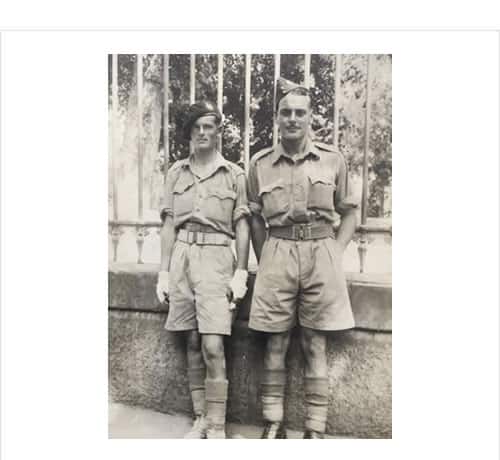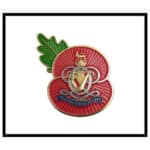This is a fantastic account sent to us by Mark Howard about his father’s exploits with the 8th King’s Royal Irish Hussars during the summer of 1942.
Having survived the disaster on 27 May 1942; the subsequent fighting around Knightsbridge, and the retreat to Mersa Matruh, Trooper Alan Howard found himself at Garawla, in the 8th Hussars ‘Composite Squadron’. The Squadron was equipped with Honeys and commanded by Major Threlfall. Captain Huth was second in command, with Captain Gwyn, Lieutenant Hall, Lieutenant Bates and Sergeant Wilmshurst as Troop Leaders. Trooper Howard was a gunner in the tank of Lieutenant Geoffrey Bates.
At 06.30 on 27 June the Composite Squadron moved south, with the intention of meeting 1st Armoured Division or at least what was left of that formation. Breasting the first escarpment, Major Threlfall’s tank had a track shot off at long range by anti-tank fire. The rest of the Squadron with Trooper Howard sought refuge in a wadi and Major Threlfall and his crew joined them on foot. Evidently, the previous night, the Germans had pushed a strong column through the British minefield and had cut the Garawla – Bir el Owin track. The enemy was engaged by 25pdr’s of the Northumbrian Division and the Hussars returned to a position two miles east of Garawla.
Early the following morning the thin-skin vehicles were ordered east and were the last to get through before that road was cut. Later in the day, the Composite Squadron reconnoitred to the south to pinpoint enemy positions in preparation for a possible breakout. Three patrols, under Lieutenant Hall, Sergeant Wilmshurst and Lieutenant Bates with Trooper Howard, moved out at 19.00 and went up a series of escarpments by different routes. The proposed start line for the breakout was reported clear. Enemy positions were identified on the second escarpment.
The patrol under Sergeant Wilmshurst found a Crusader tank bound for 1st Armoured Division driven by a Scotsman, inevitably named ‘Jock’ Stewart. In the words of the war diary, “it was persuaded to abandon its crusade” and was added to the Composite Squadron’s strength. It was to prove a fortunate encounter.
At first light the next day (29 June), the Hussars had breakfast and attended to essential maintenance in preparation for the breakout. Supplies were topped up with whatever could be found. Three petrol lorries were attached to the group. They were to accompany the Squadron in the event they successfully fought their way out.
At 17.30 the Matruh-Garawla garrison was ordered to break out that night, in small groups.
Lieutenant Bates, with Trooper Howard, led his three Honeys onto the first escarpment and at 21.15, he reported the escarpment free of enemy. The CO gave the order to break out in a close formation of three lines of tanks. The aim was to rendezvous at El Alamein.
A full moon was rising as the escarpment was cleared (years later Trooper Howard recalled the instruction was to, “run on the moon”). A southwesterly course was taken for about five miles until they hit the Qara track. Then the course was southeast, along the foot of the next escarpment, for about one and a half miles. So far, although tensions must have been high, there had been no sign of the enemy.
Eventually, the direction changed to south, heading for the Qattara Depression. Almost immediately the Hussars passed between two large enemy leaguers, about a mile apart. It seemed they might get through unobserved but then both leaguers opened up a terrific barrage. One of the petrol lorries exploded. The war diary described, “the whole scene being lit up with tracer, shell bursts and gun flashes and the only chance of safety lay in speed”.
When they were out of range and had shaken off the attention of an enemy armoured car, a halt was called. The columns had been dispersed in the melee and of the eighteen tanks, three lorries and a Dingo which had started the journey, only the Crusader commanded by Captain Wagstaffe, Captain Huth in his Dingo and six tanks, commanded by Major Threlfall, Lieutenant Hall, Sergeant Barnett, Corporal Woodford, Corporal Wells and Lieutenant Bates remained. In Lieutenant Bates’s Honey, Trooper Howard had again managed to come through the worst the enemy could throw at him.
After five minutes, the party moved slowly southeast in the hope that stragglers might see their tracks and catch up, and then speed was increased. The next six or seven miles was uneventful until a track was reached and a small enemy leaguer observed on the right. This was avoided. Shortly afterwards the Dingo went up in smoke, probably on a mine. With the enemy now alerted, Major Threlfall’s tank was hit twice by anti-tank gunfire; the force of the second explosion practically turned the tank over.
A little later Trooper Howard’s luck took a dip, as his tank was blown up on a mine. Shaken but unhurt Trooper Howard, Lieutenant Bates and the other two crewmen abandoned the wrecked tank and ran south for about a mile where they were fortunate to be picked up by Sergeant ‘Jack’ Barnett. Against orders, Sergeant Barnett had waited on the chance that they had survived. They rode on the Honey until they transferred on to the back of the larger Crusader tank, together with Major Threlfall who had also been collected with his crew.
In the moonlight, several more German leaguers were still insight, and they were still very much in hostile territory. Another tank was lost when Corporal Wells’s Honey ran out of petrol and had to be disabled by the crew. After a few more miles with no enemy in sight, a rest was called for the night. It was decided to siphon the petrol from the Honeys and go on with the Crusader, as it had a longer range. The remaining water was rationed to a quarter gallon a day per man.
In thick early morning fog on 30 June, vehicles could be heard moving but could not be identified. At 05.00 the group breakfasted before setting about disabling the Honeys. The party now comprised around twenty soldiers all riding on ‘Jock’ Stewart’s Crusader. When the fog lifted, the desert was revealed to be full of retreating British forces.
Each group seemed more than a little suspicious of the other – the enemy were also on the move and probably amongst them. With his hands raised, Lieutenant Bates approached the closest group. They were six Punjabi soldiers of an Indian company from Mersa Matruh. They joined the Crusader party. By midday, the group had grown to around forty vehicles including two Bofors guns, a 25pdr gun and a dozen Bren carriers. Continuing southeast, they reached the Qattara Depression at Qareb el Tarfaza at 13.30. One enemy column was seen but it gave no trouble.
The Crusader was nearly out of petrol but they managed to exchange cans of beer for the necessary fuel, with a passing RAOC lorry. Naturally, beer had been earlier identified as an essential supply!
The ragbag group paused for a couple of hours in the intense mid-afternoon heat at a friendly RAF wireless station. At this point, they knew they were nearly home. Trooper Howard and his fellow travellers spent the last night of their journey near Hagb el Dweis.
The Crusader party reached the safety of the British base at Burg-el-Arab at 17.00 on 1 July. Other stragglers from the 8th Hussars also met up after their own adventures and they all moved to Abbassia Camp outside Cairo.



